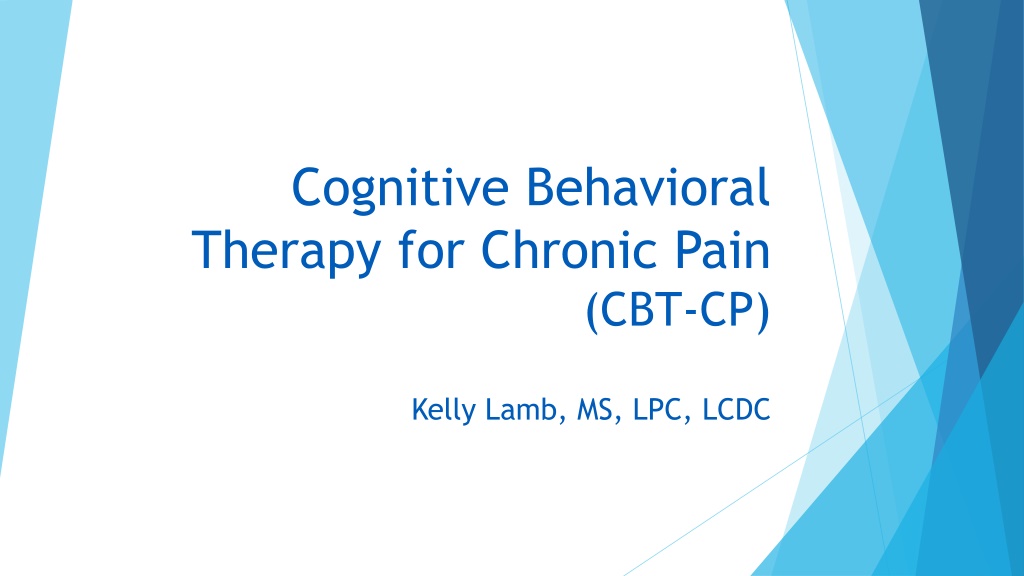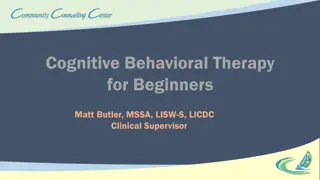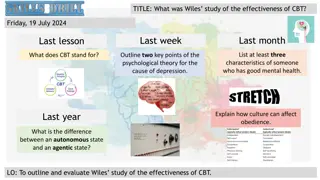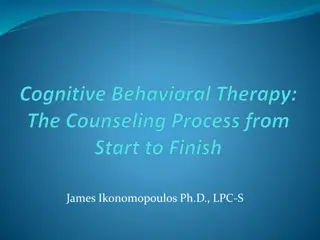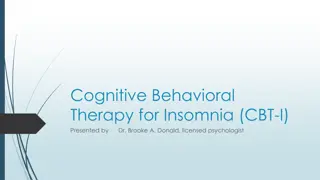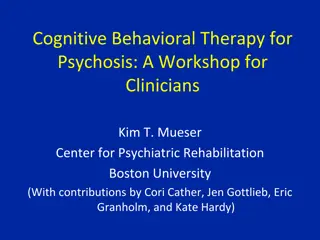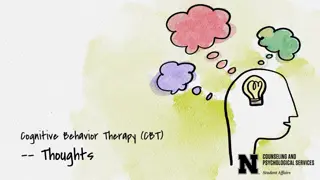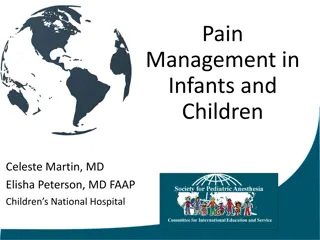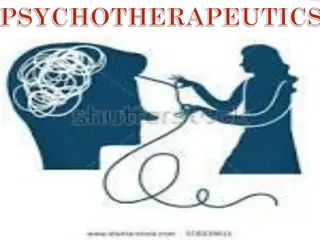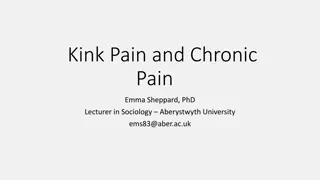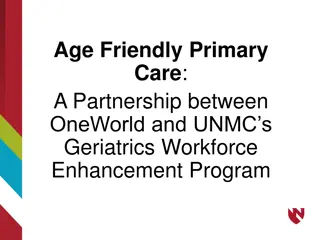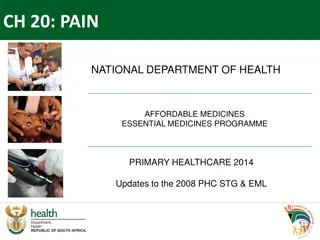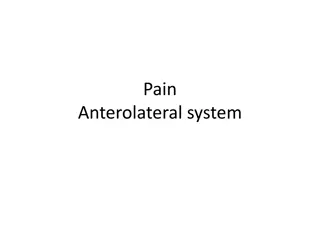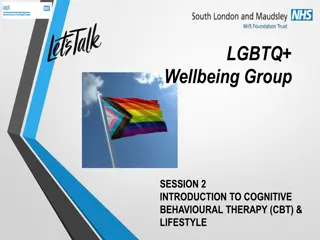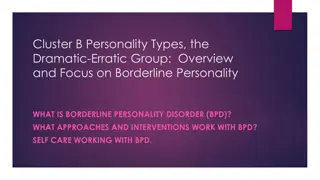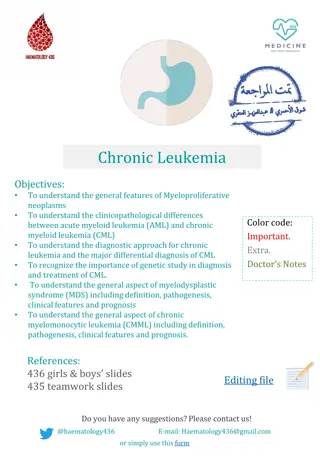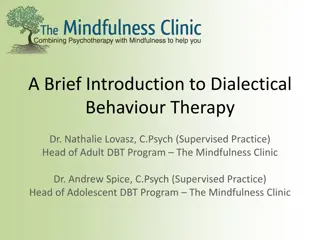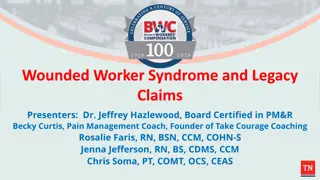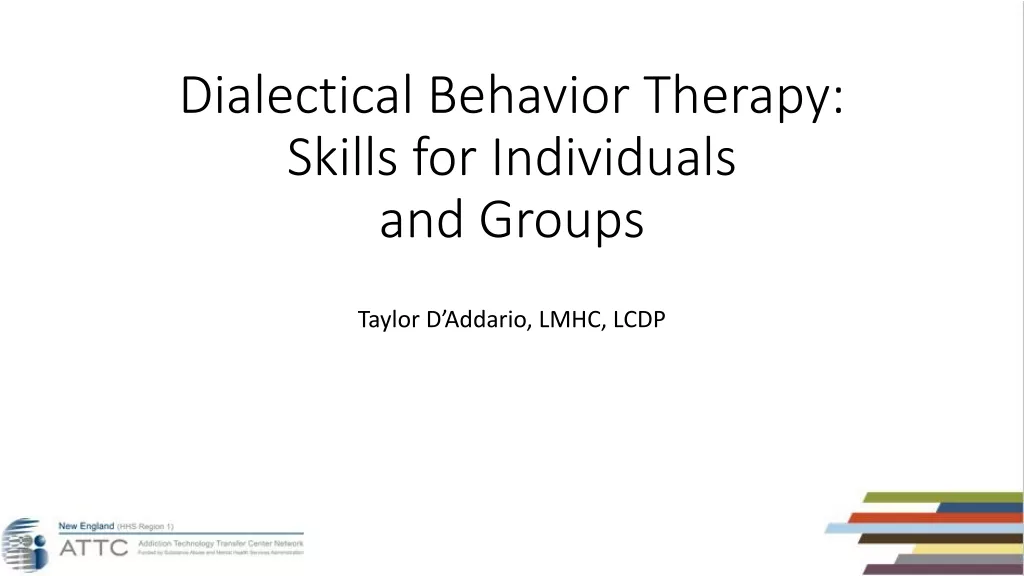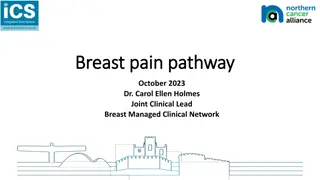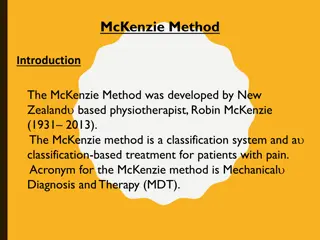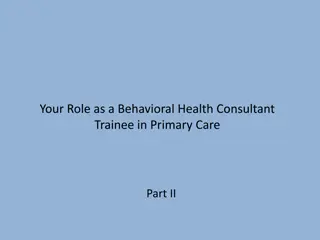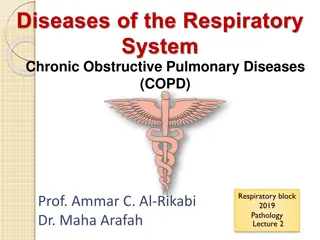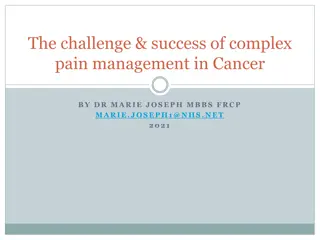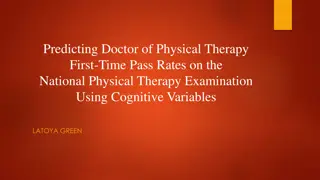Understanding Cognitive Behavioral Therapy for Chronic Pain (CBT-CP) and Counselor Role
Explore the comprehensive approach of Cognitive Behavioral Therapy for Chronic Pain (CBT-CP) focusing on therapist manuals, sessions, and considerations when interacting with patients. Discover the counselor's role in treating pain disorders, patient interactions, and the importance of mental health in managing chronic pain effectively.
Download Presentation

Please find below an Image/Link to download the presentation.
The content on the website is provided AS IS for your information and personal use only. It may not be sold, licensed, or shared on other websites without obtaining consent from the author. Download presentation by click this link. If you encounter any issues during the download, it is possible that the publisher has removed the file from their server.
E N D
Presentation Transcript
Cognitive Behavioral Therapy for Chronic Pain (CBT-CP) Kelly Lamb, MS, LPC, LCDC
Understanding Counselor Role in Treating Pain Disorders Evaluator/Consultant Data collector Educator Facilitator Motivator Reinforcer Outcomes Analyst
Considerations when Interacting with Clients Patient is often frustrated/suspicious of healthcare providers. -Angry/Unmotivated due to lack of answers They treat me like I am crazy! and I have tried everything! -Remember- They are hurting, often feel misunderstood. Critical to balance empathy and understanding with being directive and authoritative. Co-occurring disorders prevalent with Chronic Pain Patients.
Considerations when Interacting with Clients continued Patients with chronic pain may be highly focused on medication options. -Emphasize benefits of self managed care techniques. Redirect, redirect, redirect!!!! Focus on what patient CAN control. Stick with it!!!!
Why Mental Health??? My role is to help you find ways to cope better with the pain as well as to reduce the negative impact pain has on your life. Our focus will not be on finding a 'cure' or 'fix,' but on giving you more tools to manage the pain so that you can improve your quality of life .
Cognitive Behavioral Therapy for Chronic Pain (CBT-CP) Therapist Manual & Workbook Jennifer L. Murphy, Ph.D. & John D. McKellar, Ph.D. Susan D. Raffa, Ph.D. Michael E. Clark, Ph.D. Robert D. Kerns, Ph.D. Bradley E. Karlin, Ph.D.
CBT-CP: Sessions Session 1 Interview and Assessment Session 2 CBT-CP Orientation Session 3 Assessment Feedback and Goal Planning Session 4 Exercise and Pacing Session 5 Relaxation Training Session 6 Pleasant Activities 1 Session 7 Pleasant Activities 2 Session 8 Cognitive Coping 1 Session 9 Cognitive Coping 2 Session 10 Sleep Session 11 Discharge Planning Session 12 Booster Session
CBT-CP: Sessions Phone Call Interview and Assessment Session 1 CBT-CP Orientation, Assessment Feedback and Goal Planning Session 2 Exercise and Pacing Session 3 Relaxation Training Session 4 Pleasant Activities 1 & Pleasant Activities 2 Session 5 Cognitive Coping 1 & Cognitive Coping 2 Session 6 Sleep Session 7 Discharge Planning & Booster Session
Measuring Outcomes Demographics Interview/Self Report Pain Numeric Rating Scale (Pain NRS) Subjective Units of Distress Scale (SUDS) Pain Catastrophizing Scale (PCS) West-Haven Yale Multidimensional Pain Inventory - Interference (WHYMPI/MPI-INT) Beck Depression Inventory - Second Edition (BDI-II) Patient Health Questionnaire (PHQ-9) World Health Organization Quality of Life Brief (WHOQOL-BREF) Working Alliance Inventory Short Revised (WAI-SR)
Session One Pain Education: CBT-CP Patient Orientation and Goal Planning Administer SUDS Establish agenda Ensure all measures are completed Present session 1 content: CBT-CP treatment; pain cycle and biopsychosocial approach Ask patient to complete WAI-SR at session conclusion
The Development of Cognitive Behavioral Therapy Chronic Pain (CBT-CP) model The CBT-CP model developed, in part, out of the success of CBT for depression and anxiety. CBT-CP also developed out of multidimensional models of pain (gate control theory, biopsychosocial model) that emphasized cognitive and emotional factors. The CBT-CP model also borrowed heavily from the success of the behavioral model of Fordyce that emphasized extinguishing of pain behaviors Observable expressions of pain and suffering such as moaning, clenching, grimacing, sighing, or limping
The aim of this treatment is to help patient develop self-management and adaptive pain coping skills in order to increase ability to manage life.
Immediate Targets for CBT-CP Group Reduce the impact pain has on daily life Maximize daily function and improve quality of life Learn skills for coping better with pain Minimize reliance on pain medication Improve physical functioning and decrease intensity of physical pain sensations and frequency of flare-ups Decrease negative thinking and painful emotions (e.g., anger, anxiety, & depression)
Chronic Pain Cycle Distress/ Disability Chronic Pain The Costs of Inactivity Decrease Activity/ Deconditioning * More pain Avoidance/ Withdrawal * Poorer physical fitness * Less time with family and friends * Depressed mood or increased irritability * Lower self-esteem * Increased strain on relationships Negative Emotions * Decreased quality of life
Biopsychosocial Model of Pain Biological Factors Psychological Factors Social Factors
Steps to Success Check in with participants/patient Based on what you have learned do you think this is a good fit for you?? Do you have any reservations in participating, if so what are they?? Do you feel ready to take a more active approach to managing chronic pain?
SMART Goal Setting Specific- Identifies a specific action or event that will take place. Measurable- Should be quantifiable so progress can be tracked. Achievable- Should be attainable and realistic given resources. Relevant- Should be personally meaningful and really matter. Time-Bound- State the time period for accomplishing the goal.
Session 2 Acute vs. Chronic Pain Pacing and Increasing Exercise Administer SUDS Establish agenda Review session 1 Present session 2 content: Hurt versus harm, exercise program, and time-based pacing Discuss home practice
Acute Pain: Time-limited - pain lasts for no more than 6 months and goes away once body has healed Causes of pain are often known; Can cure or fix ; is considered a symptom Our bodies response to injury Survival value -Pain warns us of danger and harm (Hurt = Harm) Anxiety and fear are common; Usually go away once we know what's causing the pain or once the pain goes away May need to rest and limit activity (this allows the body to heal) Use passive treatments such as medications, injections, acupuncture Medical approach usually works
Chronic Pain Lasts longer than 3 to 6 months and does not go away once body has healed. Causes of pain are not well understood; There is no cure or fix . Is considered a condition. Limited survival value Pain does not protect or warn us of harm - nerves continue sending pain signals even after initial damage has resolved. Goes hand-in-hand with stress, fatigue, anxiety, depression, anger, irritability, and a sense of hopelessness. Need to stay active even though it hurts (Hurt does NOT equal Harm). Use active treatments Patients share responsibility and play an active role in their health care. Medical approach does not work; Bio-psycho-social approach is most effective.
Introduction to Pacing Overactivity Rest Pain
Push-Burn-Crash Cycle Patient "pushes through" the pain Patient pushes again to make up for lost time 100 90 Percent of Activity Level 80 70 With pacing, the patient keeps a steady pace to avoid pain flares 60 Without Moderation With Moderation 50 40 30 The pain gets so severe that it results in extended rest ("crash and burn") 20 Patient again crashesand burns 10 0 Day 1 Day 2 Day 3 Day 4 Day 5 Day 6 Day 7
Advantages to Pacing Moderate, thoughtful pacing improves productivity Designated start and stop points can make reaching activity goals feel less overwhelming and more attainable Accomplishing tasks without adverse consequences (e.g., drastic pain increase) improves sense of self-efficacy, increases self-esteem, and helps combat negative emotions
Discuss Home Practice Describe rationale for practice assignments. Apply skills learned during session to real-life. Extends the impact of therapy outside of session. Start practice during session. Develop assignments that are relevant to patient-centered goals. Use the term practice rather than homework Okay to adjust depending on what works for individual patients.
Increase Activity The Basics Low impact exercise that can benefit everyone with chronic pain Can lessen pain, boost strength, increase flexibility, and prevent pain flare-ups Can be done year-round regardless of weather and is integral to all activities of daily living Gradually increased walking program can help improve physical and mental health, as well as overall functioning
Exercise Options Other forms of exercise to explore with patients: Aquatic therapy Water exercises especially helpful with chronic pain since effects of gravity (essentially) disappear in water Water resistance = faster muscle toning Classes at a local YMCA or gym Stationary bicycle, recumbent bike Yoga or Tai Chi
Handling Resistance/Barriers Patient: I ve tried walking before and it didn t help Therapist: We expect you ll feel increased soreness after using muscles that you have not used in a long time, but remember that you are making your body stronger and doing the right thing for yourself and your pain. Therapist: Did you follow through with exercises at home? Did you stop walking or engaging in exercises because of increased pain?
Handling Resistance/Barriers Patient: I know my body Therapist: Based upon what we have discussed related to fear and pain, the presence of fear may complicate your assessment of what you can and cannot do. Institute pacing (to approach the feared behavior) Use proper body mechanics Some new pain is expected
Session 3 Relaxation Training Administer SUDS Establish agenda Review session 2 Present session 3 content: Relaxation rationale and strategies Discuss home practice; ask patient to complete WAI-SR at end of session
Building a Case For Relaxation Explained most easily by focusing on chronic pain as a chronic stressor, both mentally and physically When individuals experience pain, their bodies react with a flight or flight response involving an increased stress response, controlled by the sympathetic nervous system This is adaptive when faced with a dangerous or threatening situation, and is protective with acute pain With chronic pain, the prolonged physiological stress response is no longer adaptive instead it creates an ongoing stressor for the body
Types of Relaxation These are empirically validated relaxation techniques that help turn off the stress response that will be used in CBT- CP: Deep/diaphragmatic breathing Progressive muscle relaxation Guided imagery/visualization
Considerations Some patients are uncomfortable engaging in relaxation techniques because it can expose vulnerabilities This is particularly true for those with PTSD and/or anxiety disorders. Relaxation can trigger negative thoughts of traumatic events/memories Depending on the clinical needs of Veterans, the therapist may suggest helpful adaptations such as keeping their eyes open or using one of the more physically engaging techniques such as progressive muscle relaxation
Get Prepared Sit in a comfortable chair or on a mat If you get in bed you may fall asleep so this might not be ideal unless you are using the technique to aid in sleep initiation Lower the lights Take off your shoes and loosen tight clothes Close your eyes If you want to keep your eyes open, then focus them on one spot Turn off your phone, TV, and radio Put the pets in another room Let others in the house know you need some time alone to focus on your health
Potential Obstacles to Relaxation I m in too much pain to relax. Relaxation helps to manage pain Relaxation helps cope with pain If I slow down, the pain really catches up to me. I have to keep moving to keep the pain away. Pushing and constant movement without breaks increases pain Pacing is important I relax all the time- that s part of the problem! Relaxation resting, sleeping, sedentary activities Relaxation is physiological response that reduces tension and stress There s too much going on- I m just too busy to relax. Relaxation is designed to assist with stress/demands of life Relaxation aids productivity and concentration
Home Practice Materials Handouts of relaxation techniques Relaxation Practice Record Encourage patient to practice relaxation techniques at least once per day over the next week, more if possible Ask them to use the Relaxation Practice Record to track practice and progress Remind patient that as skills develop, the techniques will become easier and benefits will increase
Session 4: Pleasant Activities Administer SUDS Establish agenda Review session 3 and do guided imagery exercise Present session 4 content: Exploring pleasant activities Discuss home practice
Pleasant Activities Patient with chronic pain may have decreased their involvement in pleasant activities because: They believe they can t physically do the things they enjoy They are afraid to make plans since a pain flare may interfere They feel they are no fun to be around anymore What are the impacts of a lack of pleasant activities? Decreases quality of life Increases negative emotions and lowers self-esteem Diminishes relationships with family and friends
Benefits of Pleasant Activities Improved mood Increased socialization Healthy distraction from pain Improved self-confidence Physical reconditioning Reminder that activities pain Improved relationships
Barriers to Pleasant Activities Helping patient identify pleasant activities may be more difficult than it sounds for various reasons such as: Negative mood (e.g., depression, irritability) may lessen ability to identify activities or the motivation to engage in them Psychosocial barriers such as limited resources (e.g., money, car) Chronic pain and poor sleep lead to feeling tired and fatigued A focus on an inability to participate in physical activities like they want to or once did Explaining the benefits of engaging in pleasant activities and exploring creative and adaptive ways to participate despite pain is the goal of this session
Exploring Options Begin by asking patient about activities that: They used to enjoy doing Have always wanted to try Generate a discussion of how to engage in previously enjoyed hobbies, ones that may have been ruled out long ago Important to help patient think creatively re: adaptive ways to engage in activities Explore local resources Local sport venues, volunteer opportunities, gyms options/promotions
Barriers to Activity Scheduling There s no way I can do any activity no matter how much I pace myself. Expectations/fear of movement may lead to reluctance Encourage behavioral experiments to test expectations Start with activities that are comfortable, no matter how simple Reinforce incremental achievements I can t find the motivation to do this it s hard enough just getting out of bed every day. Use motivational enhancement strategies Sometimes, motivation follows the behavior Consider rewards as external motivation
Session 5: Cognitive Coping Skills Administer SUDS Establish agenda Review session 4 Present session 5 content: Recognizing, monitoring and challenging negative thoughts Discuss home practice and ask patient to complete WAI-SR at session conclusion
Cognitive Focus Thus far, the focus has been on changes behaviors that influence pain and functioning the focus in this sessions will be on recognizing, challenging, and adapting thoughts that are unhelpful For those with chronic pain, the role of negative cognitions can be powerful As pain persists over time, patients thoughts may become more negative and exert a greater influence on pain Often times, negative thoughts are automatic and outside of one s awareness but may still significant impact emotions and behaviors
